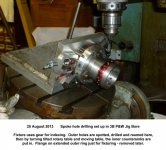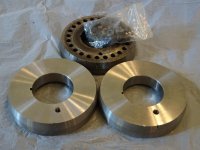Long Tom
Stainless
- Joined
- Aug 21, 2011
- Location
- Fiddlefart, Oregon
Howdy folks! It's been a while. I've been busy making chips and I hope you have too.
I've been making rear electric bike hubs for a customer that have spoke flanges with 18 holes for spokes. My indexers are Hardinge copies with 24 holes, so since the quantity of these hubs has been small I've done them on my rotary table. They are taking off for him and I need to get faster at making them, so, time for a new indexer!
Requirements are it needs to be 5c, to be able to be set up vertically, and ideally not break the bank. Since the hubs are kinda long it's important that the indexer not be TOO tall mounted in the Z axis or I'll run out of Z room on my mill..... so it'd be great if it was under 11" tall, which is what my setup now comes out to.
Any suggestions? THANKS!!
I've been making rear electric bike hubs for a customer that have spoke flanges with 18 holes for spokes. My indexers are Hardinge copies with 24 holes, so since the quantity of these hubs has been small I've done them on my rotary table. They are taking off for him and I need to get faster at making them, so, time for a new indexer!
Requirements are it needs to be 5c, to be able to be set up vertically, and ideally not break the bank. Since the hubs are kinda long it's important that the indexer not be TOO tall mounted in the Z axis or I'll run out of Z room on my mill..... so it'd be great if it was under 11" tall, which is what my setup now comes out to.
Any suggestions? THANKS!!








